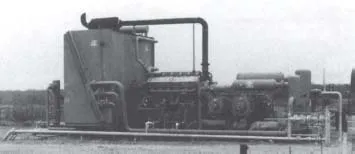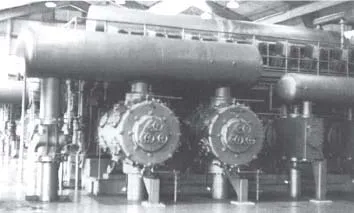
eBook - ePub
Surface Production Operations, Volume 1
Design of Oil Handling Systems and Facilities
Maurice Stewart, Ken E. Arnold
This is a test
Buch teilen
- 768 Seiten
- English
- ePUB (handyfreundlich)
- Über iOS und Android verfügbar
eBook - ePub
Surface Production Operations, Volume 1
Design of Oil Handling Systems and Facilities
Maurice Stewart, Ken E. Arnold
Angaben zum Buch
Buchvorschau
Inhaltsverzeichnis
Quellenangaben
Über dieses Buch
The latest edition of this best-selling title is updated and expanded for easier use by engineers. New to this edition is a section on the fundamentals of surface production operations taking up topics from the oilfield as originally planned by the authors in the first edition. This information is necessary and endemic to production and process engineers. Now, the book offers a truly complete picture of surface production operations, from the production stage to the process stage with applications to process and production engineers.
- New in-depth coverage of hydrocarbon characteristics, the different kinds of reservoirs, and impurities in crude
- Practical suggestions help readers understand the art and science of handling produced liquids
- Numerous, easy-to-read figures, charts, tables, and photos clearly explain how to design, specify, and operate oilfield surface production facilities
Häufig gestellte Fragen
Wie kann ich mein Abo kündigen?
Gehe einfach zum Kontobereich in den Einstellungen und klicke auf „Abo kündigen“ – ganz einfach. Nachdem du gekündigt hast, bleibt deine Mitgliedschaft für den verbleibenden Abozeitraum, den du bereits bezahlt hast, aktiv. Mehr Informationen hier.
(Wie) Kann ich Bücher herunterladen?
Derzeit stehen all unsere auf Mobilgeräte reagierenden ePub-Bücher zum Download über die App zur Verfügung. Die meisten unserer PDFs stehen ebenfalls zum Download bereit; wir arbeiten daran, auch die übrigen PDFs zum Download anzubieten, bei denen dies aktuell noch nicht möglich ist. Weitere Informationen hier.
Welcher Unterschied besteht bei den Preisen zwischen den Aboplänen?
Mit beiden Aboplänen erhältst du vollen Zugang zur Bibliothek und allen Funktionen von Perlego. Die einzigen Unterschiede bestehen im Preis und dem Abozeitraum: Mit dem Jahresabo sparst du auf 12 Monate gerechnet im Vergleich zum Monatsabo rund 30 %.
Was ist Perlego?
Wir sind ein Online-Abodienst für Lehrbücher, bei dem du für weniger als den Preis eines einzelnen Buches pro Monat Zugang zu einer ganzen Online-Bibliothek erhältst. Mit über 1 Million Büchern zu über 1.000 verschiedenen Themen haben wir bestimmt alles, was du brauchst! Weitere Informationen hier.
Unterstützt Perlego Text-zu-Sprache?
Achte auf das Symbol zum Vorlesen in deinem nächsten Buch, um zu sehen, ob du es dir auch anhören kannst. Bei diesem Tool wird dir Text laut vorgelesen, wobei der Text beim Vorlesen auch grafisch hervorgehoben wird. Du kannst das Vorlesen jederzeit anhalten, beschleunigen und verlangsamen. Weitere Informationen hier.
Ist Surface Production Operations, Volume 1 als Online-PDF/ePub verfügbar?
Ja, du hast Zugang zu Surface Production Operations, Volume 1 von Maurice Stewart, Ken E. Arnold im PDF- und/oder ePub-Format sowie zu anderen beliebten Büchern aus Technik & Maschinenbau & Chemie- & Biochemietechnik. Aus unserem Katalog stehen dir über 1 Million Bücher zur Verfügung.
Information
Chapter 1 The Production Facility
Introduction
The job of a production facility is to separate the well stream into three components, typically called “phases” (oil, gas, and water), and process these phases into some marketable product(s) or dispose of them in an environmentally acceptable manner. In mechanical devices called “separators,” gas is flashed from the liquids and “free water” is separated from the oil. These steps remove enough light hydrocarbons to produce a stable crude oil with the volatility (vapor pressure) to meet sales criteria. Figures 1-1 and 1-2 show typical separators used to separate gas from liquid or water from oil. Separators can be either horizontal or vertical in configuration. The gas that is separated must be compressed and treated for sales. Compression is typically done by engine-driven reciprocating compressors (see Figure 1-3). In large facilities or in booster service, turbine-driven centrifugal compressors, such as that shown in Figure 1-4, are used. Large integral reciprocating compressors are also used (see Figure 1-5).

Figure 1-1. A typical vertical two phase separator at a land location. The inlet comes in the left side, gas comes off the top, and liquid leaves the bottom right side of the separator.

Figure 1-2. A typical horizontal separator on an offshore platform showing the inlet side. Note the drain valves at various points along the bottom and the access platform along the top.

Figure 1-3. Engine-driven reciprocating compressor package. The inlet and inter-stage scrubbers (separators) are at the right. The gas is routed through pulsation bottles to gas cylinders and then to the cooler on the left end of the package. The engine that drives the compressor cylinders is located to the right of the box-like cooler.

Figure 1-4. Turbine-driven centrifugal compressor package. The turbine draws air in from the large duct on the left. This is mixed with fuel and ignited. The jet of gas thus created causes the turbine blades to turn at high speed before being exhausted vertically upward through the large cylindrical duct. The turbine shaft drives the two centrifugal compressors, which are located behind the control cabinets on the tight end of the skid.

Figure 1-5. A 5500-Bhp integral reciprocating compressor. The sixteen power cylinders located at the top of the unit (eight on each side) drive a crankshaft that is directly coupled to the horizontal compressor cylinders facing the camera. Large cylindrical “bottles” mounted above and below the compressor cylinders filter out acoustical pulsations in the gas being compressed.
Usually, the separated gas is saturated with water vapor and must be dehydrated to an acceptable level, normally less than 7 lb/MMscf (110 mg H2O/Sm3). This is normally done in a glycol dehydrator, such as that shown in Figure 1-6.

Figure 1-6. A small glycol gas dehydration system. The large vertical vessel on the left is the contact tower where “dry” glycol contacts the gas and absorbs water vapor. The upper horizontal vessel is the “reboiler” or “reconcentrator” where the wet glycol is heated, boiling off the water that exits the vertical pipe coming off the top just behind the contact tower. The lower horizontal vessel serves as a surge tank.
Dry glycol is pumped to the large vertical contact tower, where it strips the gas of its water vapor. The wet glycol then flows through a separator to the large horizontal reboiler, where it is heated and the water boiled off as steam.
In some locations it may be necessary to remove the heavier hydrocarbons to lower the hydrocarbon dew point. Contaminants such as H2S and CO2 may be present at levels higher than those acceptable to the gas purchaser. If this is the case, then additional equipment will be necessary to “sweeten” the gas.
The oil and emulsion from the separators must be treated to remove water. Most oil contracts specify a maximum perce...